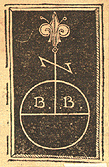
1487, Brescia: BONINO DE' BONINI
This Comedy with the Landino commentary is generally considered the
masterpiece of Brescian printing during the 15th century. With its 68 woodcuts
and typographical decorum, this folio edition evidently sought to present
itself as unique in a market increasingly frequented by editions of Dante.
It is the second illustrated edition of the Comedy, after the Florentine
edition of 1481, but the first to be illustrated by woodcuts. Folio size
designs illustrate all the cantos of the Inferno and Purgatorio
and the first canto of the Paradiso. They are framed by beautiful
borders cut upon a black background with classical motifs -- vases, swirls,
ornamental masks -- all inserted within exquisitely crafted candelabra.
The woodcuts are done by various hands, with the first nineteen based upon
Botticelli's designs for the Florentine 1481 edition. The other woodcuts
which adorn this Comedy in turn became models for later illustrated
editionsof the poem, including the Venetian editions of the 1490s (see the
next four items). The edition also had philological pretensions, and reveals
the hand of a corrector who sought a measure of orthographic standardization.
The text appears to have been based upon the collation (i.e., comparison)
of the 1481 edition with a manuscript.
The Dalmatian Bonino Bonini came to Brescia in 1483 after initial experience
as a printer in Venice (he published his only Venetian edition, Lactantius'
Divinae institutiones, in 1475). Bonini combined excellent technical
skill, good typographical taste, and a sharp sense for commercial organization.
In eight years of activity between June 1483 and the beginning of 1491,
Bonini printed more than forty editions, averaging 5.5 editions per year,
the highest rate among all Brescian printers in the 15th century. More than
half of his editions pertain to the humanistic genre of classics and commentaries
to classics. Later during his career at Brescia he diversified into the
lucrative legal market by offering juridical works and statutes. Bonino
left Brescia in 1491 and resettled in Lyons, where he became a successful
bookseller and editor.

